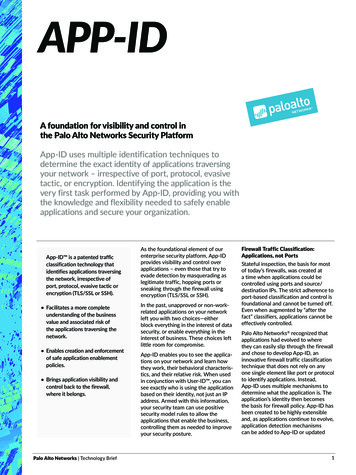
Transcription
APP-IDA foundation for visibility and control inthe Palo Alto Networks Security PlatformApp-ID uses multiple identification techniques to determine the exact identity of applications traversingyour network – irrespective of port, protocol, evasivetactic, or encryption. Identifying the application is thevery first task performed by App-ID, providing you withthe knowledge and flexibility needed to safely enableapplications and secure your organization.App-ID is a patented trafficclassification technology thatidentifies applications traversingthe network, irrespective ofport, protocol, evasive tactic orencryption (TLS/SSL or SSH). Facilitates a more completeunderstanding of the businessvalue and associated risk ofthe applications traversing thenetwork. Enables creation and enforcementof safe application enablementpolicies. Brings application visibility andcontrol back to the firewall,where it belongs.Palo Alto Networks Technology BriefAs the foundational element of ourenterprise security platform, App-IDprovides visibility and control overapplications – even those that try toevade detection by masquerading aslegitimate traffic, hopping ports orsneaking through the firewall usingencryption (TLS/SSL or SSH).In the past, unapproved or non-workrelated applications on your networkleft you with two choices—eitherblock everything in the interest of datasecurity, or enable everything in theinterest of business. These choices leftlittle room for compromise.App-ID enables you to see the applications on your network and learn howthey work, their behavioral characteristics, and their relative risk. When usedin conjunction with User-ID , you cansee exactly who is using the applicationbased on their identity, not just an IPaddress. Armed with this information,your security team can use positivesecurity model rules to allow theapplications that enable the business,controlling them as needed to improveyour security posture.Firewall Traffic Classification:Applications, not PortsStateful inspection, the basis for mostof today’s firewalls, was created ata time when applications could becontrolled using ports and source/destination IPs. The strict adherence toport-based classification and control isfoundational and cannot be turned off.Even when augmented by “after thefact” classifiers, applications cannot beeffectively controlled.Palo Alto Networks recognized thatapplications had evolved to wherethey can easily slip through the firewalland chose to develop App-ID, aninnovative firewall traffic classificationtechnique that does not rely on anyone single element like port or protocolto identify applications. Instead,App-ID uses multiple mechanisms todetermine what the application is. Theapplication’s identity then becomesthe basis for firewall policy. App-ID hasbeen created to be highly extensibleand, as applications continue to evolve,application detection mechanismscan be added to App-ID or updated1
Decryption(SSL or SSH)DecodeCheckSignaturesPolicyCheckK NO W N P R O T O C O L DEC ODE RCheck ApplicationSignaturesPolicy CheckCheckIP/PortPolicy CheckStartIDE N T IF IE D T R A F F IC (NO DEC ODING)Apply HeuristicsPolicyCheckUNK NO W N P R O T O C O L DEC ODE RREPORT & ENFORCE POLICYFigure 1: How App-ID classifies traffic.as a means of keeping pace with theever-changing application landscape.App-ID Traffic ClassificationTechnologyin place, then decryption is not employed. A similar approach is used withSSH to determine if port forwarding isin use as a means to tunnel traffic overSSH. Such tunneled traffic is identifiedas ssh-tunnel and can be controlled viasecurity policy.Using as many as four differenttechniques, App-ID determines whatthe application is as soon as the traffic Application and Protocol Decoding:hits the firewall appliance, irrespectiveDecoders for known protocols areof port, protocol, encryption (TLS/SSLused to apply additional context-basedor SSH) or other evasive tactic. Thesignatures to detect other applicationsnumber and order of identificationthat may be tunneling inside of themechanisms used to identify theprotocol (e.g., Yahoo! Messenger usedapplication will vary depending onacross HTTP). Decoders validate thatthe application. The general flow forthe traffic conforms to the protocolApp-ID is as follows:specification and they provide support for NAT traversal and opening Application Signatures: Signatures aredynamic pinholes for applications suchused first to look for unique applias VoIP or FTP. Decoders for popularcation properties, and related transapplications are used to identify theaction characteristics, to correctlyindividual functions within the appliidentify the application regardless ofcation as well (e.g., webex-file-sharthe protocol and port being used. Theing). In addition to identifying applicasignature also determines if the applitions, decoders identify files and othercation is being used on its default portcontent that should be scanned foror a non-standard port (for example, threats or sensitive data.RDP across port 80 instead of porthere, to provide visibility into applications that might otherwise elude positive identification. The actual heuristicsused are specific to an application andinclude checks based on such thingsas the packet length, session rate, andpacket source.With App-ID as the foundationalelement of our security platform, yoursecurity team can regain visibility into,and control over, the applicationstraversing your network.App-ID: Dealing with Custom orUnknown ApplicationsNew applications are added to theApp-ID database weekly, yet nearlyevery network will still have caseswhere unknown application trafficis detected. There are typically threescenarios where unknown traffic willbe detected: a commercially availableapplication unknown to App-ID, aninternal custom application, or a threat.Unknown Commercial Applications:Using visibility tools, you can quicklydetermine if the traffic is a commercialoff-the-shelf (COTS) application. If it isa COTS application, you can captureand submit traffic packets to Palo AltoNetworks for App-ID development.The new App-ID is developed, tested,and added to the database for all usersin the form of a weekly update.3389, its standard port). If the identi- Heuristics: In certain cases, evasivefied application is allowed by securityapplications still cannot be detectedpolicy, further analysis of the traffic iseven through advanced signature anddone to identify more granular appliprotocol analysis. In those situations, it iscations as well as scan for threats.necessary to apply additional heuristic,or behavioral analysis to identify cer TLS/SSL and SSH Decryption: If App-IDtain applications, such as peer-to-peerdetermines that TLS/SSL encryptionfile sharing or VoIP applications thatis in use and a decryption policy isuse proprietary encryption. Heuristicin place, the traffic is decrypted and Internal or Custom Applications: If theanalysis is used as needed, with thethen passed to other identificationapplication is internal, or custom, youother App-ID techniques discussedmechanisms as needed. If no policy isPalo Alto Networks Technology Brief2
can create a custom App-ID using aset of available protocol and application decoders. Once the customApp-ID is developed, your internal application is classified and inspected inthe same manner as applications withstandard App-IDs. Custom App-IDsare managed in a separate databaseon the device, ensuring they are notimpacted by the weekly (commercial)App-ID updates. Threats: Once the commercial andinternal applications have beenaddressed, the third possible sourceof unknown traffic is threats. Heretoo, you can quickly determine therisk l evels using the behavioral botnet report or other forensics tools toisolate the characteristics and applyappropriate policy control.Even after attempts to identify, sometraffic in the system may remainunknown. Because our firewall supportsa positive enforcement model, theremaining unknown traffic can beblocked (by default) or allowed buttightly controlled by policy if desired.Alternative offerings (e.g., Intrusion Prevention Systems) are based on negativecontrol and will allow unknown trafficto pass through without providing anysemblance of visibility or control.How App-ID Works: IdentifyingWebExWhen a user initiates a WebEx session,the initial connection is an encryptedcommunication. With App-ID, thedevice sees the traffic and the signatures determine that it is using TLS/SSL.The decryption engine and protocoldecoders are then initiated to decryptthe TLS/SSL and detect that it is HTTPtraffic. Once the decoder has the HTTPstream, App-ID can apply contextualsignatures and detect that the application in use is WebEx. At this pointthe session traffic becomes known asWebEx traffic by the firewall. Visibility(e.g., ACC in the user interface) andcontrol of the WebEx traffic via securitypolicy are enabled.traversing your network. Learningwhat the application does, the ports ituses, its underlying technology, and itsbehavioral characteristics is the nextstep toward making a more informeddecision about how to treat the application. Once a complete picture of usageis gained, you can apply policies with arange of responses. Examples include: Allow or deny Allow but scan for exploits, virusesand other threats Allow based on schedule, users orgroups Control file or sensitive data transfer Decrypt and inspect Apply traffic shaping through QoSIf the end user were to initiate the Apply policy-based forwardingWebEx Desktop Sharing feature, this“mode-shift” from conferencing to Allow a subset of applicationremote access would be detected by functionsApp-ID. Again, visibility to this specificapplication function would be provided – Any combination of the aboveand policy control over WebEx DesktopWith App-ID as the foundationalSharing would be possible (distinct fromelement of our firewalls, you cangeneral WebEx use).restore visibility and control over theapplications and traffic traversing yourApplication Identity: The Heart ofnetwork.Policy ControlIdentifying the application is the firststep in learning more about the trafficFigure 2: Application Function Control – maximize productivity by safely enabling theapplication itself (Microsoft SharePoint) or individual functions.Palo Alto Networks Technology Brief3
Application Function-Level ControlsTo many customers, safe applicationenablement means striking an appropriate security policy balance by enablingsome application functions whileblocking others. Examples include: Allowing Microsoft SharePoint Documents, but blocking the use ofSharePoint Administration. Block Facebook -mail, -chat, -postingand -apps, but allow Facebook itself,effectively only allowing users tobrowse Facebook. Enable the use of MSN , but disable theuse of MSN-file transfer – or only allowcertain file types to be transferred.Using an application hierarchy thatincludes the base application andsupporting functions, App-ID makes iteasy for you to choose which applications to allow overall, while blockingor controlling functions within theapplication. Figure 2 shows SharePoint as the base application, and theindividual functions within.Controlling Multiple Applications:Dynamic Filters and GroupsFigure 3 below shows a snapshot viewof Palo Alto Networks online application database. Here you can browse thecurrent database of App-IDs, includingan interactive view of applicationsbased on the same criteria that can beused in dynamic filters.There are cases where you may wantto control larger groups of applicationsin bulk, as opposed to controlling themindividually. The two mechanisms thataddress this policy requirement aredynamic filters and application groups. Application Groups: An applicationgroup is defined as a static list ofDynamic Filters: A dynamic filter is aapplications. An example would be aset of applications that is created basedgroup of remote management applion any combination of the filter criteria:cations such as RDP, Telnet, and SSH.category, subcategory, behavioral charIn a typical organizational scenario,acteristic, underlying technology or riskeach of these applications is used byfactor. Security policies (e.g. deny, allow,support and IT personnel, yet employscan) can be applied to dynamic filters.ees who fall outside of these groupsThe security policy is then enforcedare also known to use them as a meansfor application traffic that matches theto access their home networks. An apfilter criteria.plication group can be created, with anAs new App-IDs are introduced andassociated security policy that allowsdelivered to the firewall via weeklyuse only by support and IT personupdates, dynamic filters are automatnel (supported by User-ID). As newically updated for those applicationsemployees join the organization, theythat meet the filter criteria. This helpsneed only be added to the appropriateminimize administrative effort associatdirectory group. No updates are needed with security policy management.ed to the security policy itself.Figure 3: Browse up-to-date application research and analysis at the Palo Alto NetworksApplication Research Center, https://applipedia.paloaltonetworks.comPalo Alto Networks Technology Brief4
Expanding the List of ApplicationsThe list of App-IDs is expanded weeklywith 3 to 5 new applications typicallyadded based on input from customers,partners, and market trends. When youfind unidentified applications on yournetwork, you can capture the traffic andthen submit the information for App-IDdevelopment. Once a new App-ID is eveloped and tested, it is added todthe list as part of the weekly contentupdates.SummaryApp-ID is a powerful and differentiated core capability of the PaloAlto N etworks Next-GenerationFirewall, enabling advanced visibility4401 Great America ParkwaySanta Clara, CA 95054Main:Sales:Support: 1.408.753.4000 1.866.320.4788 1.866.898.9087www.paloaltonetworks.comand granular control of traffic in your network. With this visibility and control,you can evaluate what is taking placein your environment, and then definepolicies that: ensure appropriate use,reduce attack surface, and stop threats.Ultimately, App-ID is a key foundationalelement in enabling superior riskmanagement for your organization. 2015 Palo Alto Networks, Inc. Palo Alto Networks is a registered trademarkof Palo Alto Networks. A list of our trademarks can be found at .html. All other marks mentionedherein may be trademarks of their respective companies.pan-tb-app-id-092115
Using visibility tools, you can quickly determine if the traffic is a commercial off-the-shelf (COTS) application. If it is a COTS application, you can capture and submit traffic packets to Palo Alto Networks for App-ID development. The new App-ID is developed, tested, and added to the database for all users in the form of a weekly update.











